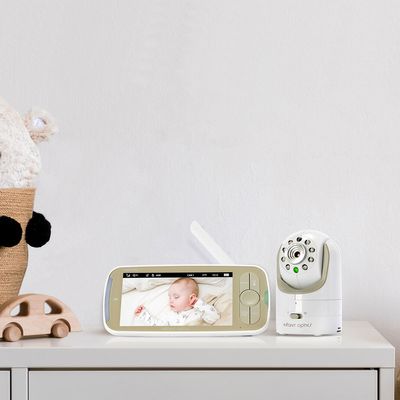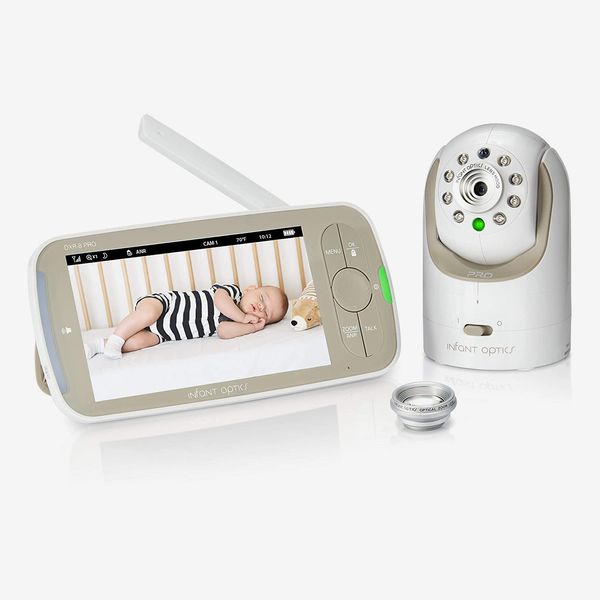

Photo: Courtesy of the retailer
A baby monitor at its most basic allows you to see and hear your child while they sleep in another room. A traditional one uses local radio frequency, while a new crop of Wi-Fi-enabled monitors offer additional features like tracking sleep patterns, growth, and breathing. As a mom of two young boys, I’ve learned over the years that the most important thing a baby monitor should do is display your baby clearly and reliably. The rest is extra. But with so many options out there, from audio-only monitors to high-tech biometric-tracking devices, choosing one that’s right for your family can feel daunting.
According to Jennifer LaBracio, the gear editor at the baby-registry website Babylist, the right baby monitor will depend on “the space you live in and your personality and parenting style.” For example, a family that lives in a big house might need something different from one that lives in a smaller apartment. A smart monitor that can analyze sleep patterns might make some parents feel more confident, but it could cause others undue stress. To help you navigate the vast universe of baby monitors, I tested several different models over the years with my kids (ages 5 and 2) and also consulted experts, including parenting bloggers, sleep consultants, and parents, about their favorites. If I’m being honest, no monitor is perfect, though a couple come close. My recommendations below include everything from traditional video monitors to “smart” devices that can track how your baby is sleeping to a simple and truly affordable audio monitor, should that be all you require. Below, the eight best baby monitors for every family and budget.
Update on February 25, 2025: Added additional review notes to the Infant Optics, Nanit, and Motorola monitors; updated prices and checked stock for all other products.
The biggest decision you’ll have to make is whether you want a baby monitor that uses a local radio frequency or one that’s Wi-Fi enabled. A local video baby monitor uses a radio-frequency-based system to transmit sight and sound and requires both a camera and a “parent unit” (a.k.a. a separate viewing device or screen), while a Wi-Fi monitor usually only comes with the camera and requires a phone app to view the feed. There are pros and cons to both. The connection on a standard local video monitor is more reliable than on a Wi-Fi-enabled one since it doesn’t rely on the internet, which could go out at any given moment. It’s more secure and is less likely to be hacked since it’s not on any sort of network. But this means you can’t watch the baby when you’re outside the house. Plus the range between the camera and the display unit can be limited depending on the size and layout of your home. (All the devices on this list top out at 1,000 feet, which is on the higher end.)
Wi-Fi monitors allow you to check in on your child from the office or a rare date night out — or anywhere in the world, for that matter, via an app on your phone, giving you more flexibility and control. While most companies promise a secure and private connection, there’s always the possibility of getting hacked, which sounds terrifying but actually doesn’t happen that often. Wi-Fi monitors are generally more expensive. But an internet-connected device means it can be a smart one, providing you with a lot more data tracking and insight into how your baby sleeps. They can also be invaluable for sleep-training purposes, according to Elizabeth King, the founder of the sleep-consulting company Sleep Baby. King encourages parents to “take what a monitor tells you and use your gut and your parenting knowledge to react to your baby.”
Because the point of a monitor is to keep eyes on your baby when you’re not in the room with them, being able to see your child clearly is important. Look for a monitor that provides a high-quality HD-video feed (and sound), and if you’re using one with a physical screen, make sure it’s big enough (most of the non-smart units on this list have five-inch screens).
Pay attention to the physical camera as well. Some Wi-Fi monitors’ cameras are fixed, meaning you can’t pan, tilt, zoom, or otherwise adjust them remotely, which you can do with a radio-frequency unit. But depending on the positioning of the camera, you should be able to get a clear view. A lot of the smart monitors are placed directly over the crib, giving you a bird’s-eye view of your little one, which takes care of the problem.
At its most basic, a video monitor will show you what’s going on in your baby’s room. Non-Wi-Fi models like the ones on this list come with other convenient features to enhance that experience, including night vision, a two-way talk radio, a room-temperature indicator, a time display, and remote pan, tilt, and zoom abilities.
Smart monitors come with all these features and then some. The latest crop uses the camera — sometimes with accessories, sometimes without — to track the sleep habits of your baby and other data such as breathing patterns. This turns the monitor into something of a virtual sleep coach that analyzes when your child falls asleep (and how long it takes them to do so), how long they sleep for, whether they wake up during the night, and more. A smart monitor can help you sleep better at night, especially if you’re anxious about whether your baby is breathing normally, for instance. That being said, some of this data could be unnecessary for most parents, so think about what will actually be useful to you before you settle on a monitor.
Still, Natalie Nevares, founder of Mommywise and a sleep-training expert who coaches new parents, reminds us that any monitor — even the most sophisticated like the Nanit (see below) — won’t be 100 percent accurate in the sleep tracking it provides. Sleep consultant Jennifer Metter adds that any data you get from a smart monitor should be considered in consultation with your baby’s doctor, because “parents do not know how to identify what normal, healthy sleep looks like for babies and children.” And as much as LaBracio loved having access to sleep insights provided by the Nanit for her infant, she agrees that it’s helpful to be familiar with infant sleep patterns, so you’re not too caught up in the details that the analytics provide. “If you’re a person who is going to get more anxious from seeing the data, then it’s probably not the monitor for you.”
Type: Non-Wi-Fi video monitor, 1,000-foot range | Video display: 720p HD camera, 5-inch display | Features: 270-degree pan (135 degrees left and right); 110-degree tilt (95 degrees up and 25 degrees down); LED sound indicator, active noise-reduction technology; Connect up to four cameras
The Infant Optics DXR-8 Pro baby monitor is my favorite monitor out of the many I have tried over the five-plus years I have been a parent. It’s popular among Amazon reviewers, Babylist users, and Strategist staffers. (New York Magazine deputy editor Alexis Swerdloff used it with her second child.) I started off with the basic DXR-8 model when my older son was born, then upgraded to the new one a couple of years later, and it’s still the one I use today now that he’s almost 6 years old. It’s so easy to use that I bought a second camera to place in my younger son’s room so that I…

